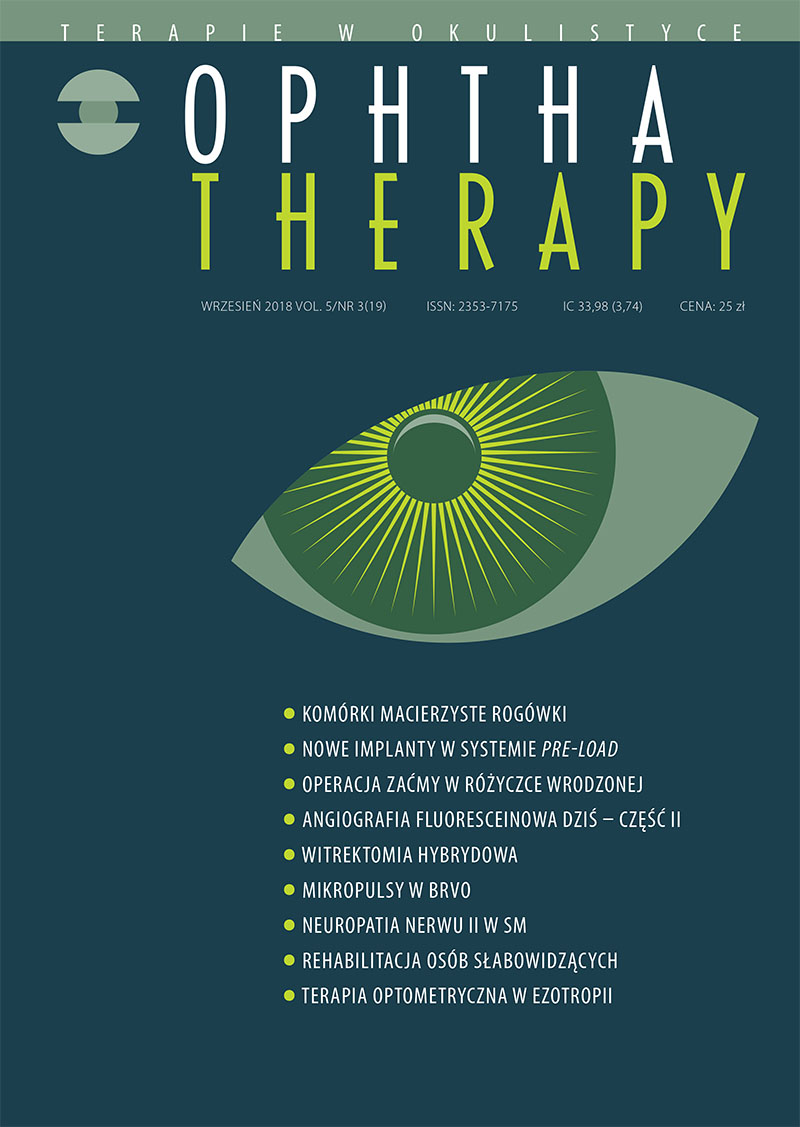Visual function after bilateral secondary implantation of the lens, which have been made 18 years after congenital cataract extraction in the patient with congenital rubella syndrome
Main Article Content
Abstract
Comparison of a quality of vision and changes in a everyday function in 18 years old patient with congenital rubella syndrome and concomitant nystagmus who was undergoing onetime secondary implantation of intraocular lenses. A congenital cataract extraction has been done in the first years of his life. An eye defect of high hyperopia was a consequence of postoperative aphakia and has never been corrected before. A lack of cooperation from the patient was a consequence of mental retardation. Secondary lens implantations have been done to the sulcus, onetime to the both eyes. The procedure was done under total anaesthesia. An electrophysiology examinations were taken before and 24 months after the surgery. A total change in behavior and also an improvement of cognitive abilities which was accompanied by retinal response observed in electrophysiology examinations has been achieved after correction of high hyperopia by secondary lens implantation gained due to correction of both eyes. Correction of high hyperopia caused by postoperative aphakia after removal of congenital cataract resulted in improvement of vision quality, despite long-term, over ten years of absence of any correction of this defect. Obtaining this improvement effect should be an incentive to consider secondary implantation in every case, especially when the other senses (hearing) and communication organs (speech) are also disturbed, regardless of the period of non-correction.
Downloads
Article Details

This work is licensed under a Creative Commons Attribution-NonCommercial-NoDerivatives 4.0 International License.
Copyright: © Medical Education sp. z o.o. License allowing third parties to copy and redistribute the material in any medium or format and to remix, transform, and build upon the material, provided the original work is properly cited and states its license.
Address reprint requests to: Medical Education, Marcin Kuźma (marcin.kuzma@mededu.pl)
References
2. Drews-Botsch C, Cotsonis G, Celano M et al. Assessment of Adherence to Visual Correction and Occlusion Therapy in the Infant Aphakia Treatment Study. Contemp Clin Trials Commun. 2016; 3: 158-66.
3. Rong X, Ji Y, Fang Y et al. Long-Term Visual Outcomes of Secondary Intraocular Lens Implantation in Children with Congenital Cataracts. PLoS One. 2015; 10(7): e0134864.
4. Lambert SR, Buckley EG, Drews-Botsch C et al.; The infant Aphakia Treatment Study Group. Design and Clinical Measures at Enrollment. Arch Ophthalmol. 2010; 128(1): 21-7.
5. Giles K, Christelle D, Yannick B et al. Cataract surgery with intraocular lens implantation in children aged 5-15 in local anaesthesia: visual outcomes and complications. Pan Afr Med J. 2016; 24: 200.
6. Tassignon MJ. Bag-in-the-lens cataract surgery. Online: https://www.aao.org/clinical-video/bag-in-lenscataract-surgery.
7. Wood KS, Tadros D, Trivedi RH et al. Secondary intraocular lens implantation following infantile cataract surgery: intraoperative indications, postoperative outcomes. Eye (Lond). 2016; 30(9): 1182-6.
8. Kruger SJ, DuBois L, Becker ER et al. Cost of Intraocular Lens vs. Contact Lens Treatment after Unilateral Congenital Cataract Surgery in the IATS at Age 5 Years. Ophthalmology. 2015; 122(2): 288-92.
9. Plager DA, Lynn MJ, Buckley EG et al. Complications in the first 5 years following cataract surgery in infants with and without intraocular lens implantation in the Infant Aphakia Treatment Study. Am J Ophthalmol. 2014; 158(5): 892-8.
10. Tan X, Lin H, Lin Z et al. Capsular Outcomes After Pediatric Cataract Surgery Without Intraocular Lens Implantation: Qualitative Classification and Quantitative Measurement. Medicine (Baltimore). 2016; 95(10): e2993.
11. Sale A, Berardi N. Active training for amblyopia in adult rodents. Front Behav Neurosci. 2015; 9: 281.
12. Sawaya RA, Haddad RS. Effect of cataract on pattern reversal visual evoked potential. Ann Ophthalmol. 2002; 34: 190-3.
13. Sloper JJ, Collins AD. Delayed visual evoked potentials in adults after monocular visual deprivation by a dense cataract. Invest Ophthalmol Vis Sci. 1995; 36(13): 2663-71.
14. McCulloch DL, Skarf B. Pattern reversal visual evoked potentials following early treatment of unilateral, congenital cataract. Arch Ophthalmol. 1994; 112: 510-8.

